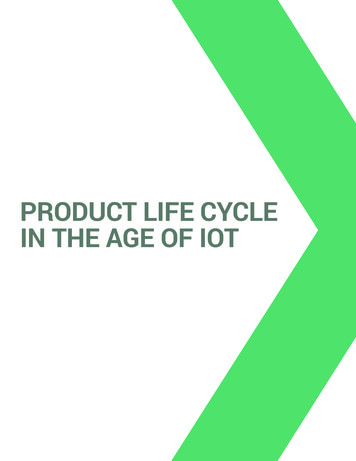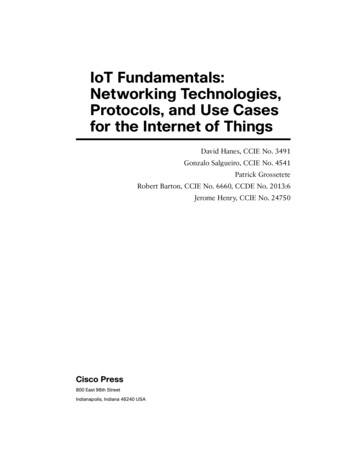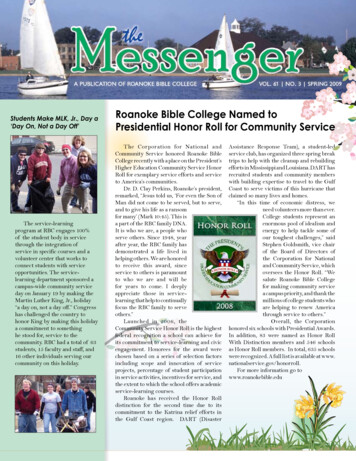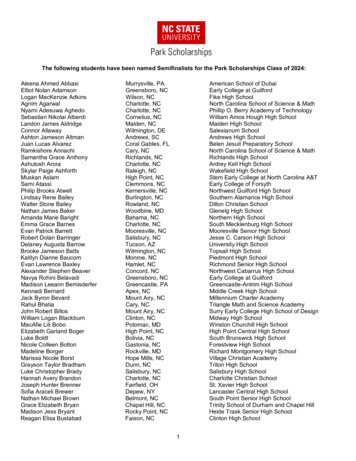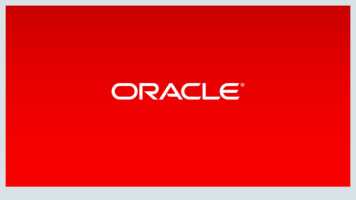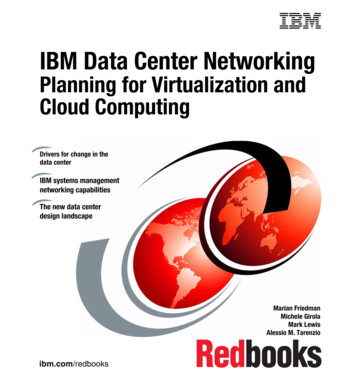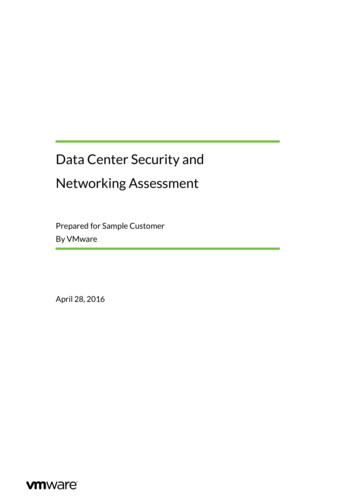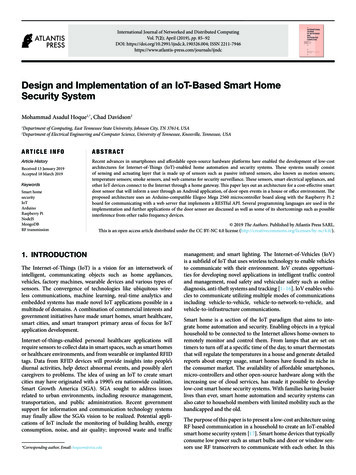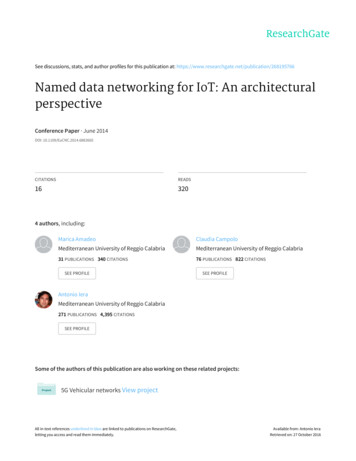
Transcription
See discussions, stats, and author profiles for this publication at: Named data networking for IoT: An architecturalperspectiveConference Paper · June 2014DOI: 10.1109/EuCNC.2014.6882665CITATIONSREADS163204 authors, including:Marica AmadeoClaudia CampoloMediterranean University of Reggio CalabriaMediterranean University of Reggio Calabria31 PUBLICATIONS 340 CITATIONS76 PUBLICATIONS 822 CITATIONSSEE PROFILESEE PROFILEAntonio IeraMediterranean University of Reggio Calabria271 PUBLICATIONS 4,395 CITATIONSSEE PROFILESome of the authors of this publication are also working on these related projects:5G Vehicular networks View projectAll in-text references underlined in blue are linked to publications on ResearchGate,letting you access and read them immediately.Available from: Antonio IeraRetrieved on: 27 October 2016
2014 IEEE, Personal use of this material is permitted. Permission from IEEE must be obtained for all other uses, in any current or future media, includingreprinting/republishing this material for advertising or promotional purposes, creating new collective works, for resale or redistribution to servers or lists, or reuse of anycopyrighted content of this work in other works.This is the final submitted version of the paper published in: Proceedings of the EuCNC 2014 Conference, Year 2014, Pages: 1-5, DOI: 10.1109/EuCNC.2014.6882665Named Data Networking for IoT:an Architectural PerspectiveMarica Amadeo, Claudia Campolo, Antonio Iera, Antonella MolinaroUniversity “Mediterranea” of Reggio Calabria - DIIES DepartmentEmail: {name.surname}@unirc.itAbstract—The Named Data Networking (NDN) project isemerging as one of the most promising information-centric futureInternet architectures. Besides NDN recognized potential as acontent retrieval solution in wired and wireless domains, itsinnovative concepts, such as named content, name-based routingand in-network caching, particularly suit the requirements ofInternet of Things (IoT), interconnecting billions of heterogeneousobjects. IoT highly differs from today’s Internet due to resourceconstrained devices, massive volumes of small exchanged data,and traffic type diversity. The study in this paper addresses thedesign of a high-level NDN architecture, whose main componentsare overhauled to specifically meet the IoT challenges.Index Terms—Named Data Networking, Internet of ThingsI. I NTRODUCTIONThe proliferation of low-cost sensing and actuator devicestogether with the advancement in wireless communicationtechnologies offer unprecedented opportunities for the supportof applications that cut across many areas of modern day living(e.g., healthcare, smart home, sustainable transportation).The urge for connecting and integrating such devices at aglobal scale has pushed towards the Internet of Things (IoT) vision. IETF working groups have proposed a suite of protocolsand open IP-based standards to prevent wireless sensor andactuator networks (WSANs) to work in isolation by relying onInternet connections. The advantages of using IP are manifold:it is a well-defined open standard, enabling communicationcompatibility between entities in different domains. However,there are still open challenges to date in deploying IP-basedIoT solutions on a large scale [1]. In addition to arisingstringent application and device requirements (e.g., scalability,robustness, power efficiency) intrinsic to IoT, such solutionsinherit issues strictly related to the host-centric IP paradigmthat impact communication performance in the current (andfuture) Internet. The use of IP addresses, in fact, implies (i) theneed of additional resolution systems to translate applicationlevel requests (e.g., in the form of Uniform Resource Identifier), into IP addresses; (ii) connection-oriented end-to-endsecurity; (iii) additional (burdensome) protocols to supportmobility.This is why the research community is currently exploringcutting-edge and clean-slate approaches to transform the Internet. The Information Centric Networking (ICN) paradigm[2] has been recently proposed to this purpose. Unlike theThis work has been carried out within the national research projectPON03PE 00050 DOMUS “Home automation systems for a cooperativeenergy brokerage service”.host-centric IP-based networking, in ICN the content is thefirst class network citizen: nodes specify what they searchfor and not where they expect it to be provided. Every datais a self-authenticating and self-identifying unit, which canbe required by any interested authorized consumer by usinga unique, persistent, location-independent name. In-networkcaching, multicasting and mobility are natively supported. Inthis research arena, the Named Data Networking architecture(NDN) [3] has rapidly gained consensus thanks to its simplecommunication model, scalable naming and lightweight configuration and management operations [4]. NDN features makeit also a particularly promising solution to fit the peculiaritiesof the IoT ecosystem [1] (Section III), where applicationsspanning several domains may request the same data, regardless of their provenance, and billions of heterogeneous(constrained) nodes need to communicate.Motivated by such unique challenges imposed by IoT,we take a top-down approach to develop a high-level NDNarchitecture for this domain and specify its main components(Section IV). At the heart of our design there is the clearidentification of a management and control plane in thetraditional NDN fabric. It accounts for the configuration andmanagement of services and devices, for the types of IoT dataexchange (e.g., on-demand sensing/action triggering, periodicmonitoring, event-triggered alarms) and their demands (e.g., interms of security, reliability, timeliness, local relevance), and itforges accordingly the Strategy layer, responsible for transportand forwarding routines. The work would also serve thepurpose of incentiving the research community to contributeto a full-fledged Future Named Data Internet of Things.II. NDNIN A NUTSHELLThe NDN architecture is based on the Content CentricNetworking proposal, presented by Jacobson et al. in [5]. Itdefines a simple and robust receiver-driven communicationmodel based on the exchange of two packets types, Interest andData, which carry hierarchical, application-specific contentnames. NDN deals with content integrity and authenticityby piggybacking the data publisher’s signature and otherauthentication information in each Data. Depending on localconstraints and policies, a subset (or all) of the network nodescan cache contents in order to speed up data retrieval whilereducing the network overhead.As shown in Figure 1, NDN inherits the hourglass model ofthe IP architecture, but the narrow waist leverages names of
contents instead of IP addresses for data delivery. Each NDNnode maintains three data structures: (i) a Content Store (CS)for temporary caching of incoming Data packets; (ii) a routingtable named Forwarding Information Base (FIB) used to guidethe Interests towards Data; and (iii) a Pending Interest Table(PIT), which keeps track of the forwarded Interest(s) that arenot yet satisfied with a returned Data packet.Each NDN node receiving an Interest acts as follows tomake its forwarding decisions. First, it searches for a nameprefix longest-match in its content store. If a match is found,then the node sends the Data back to the incoming interfaceof the processed Interest. Otherwise, if there is a matchingPIT entry, the Interest is discarded because an equal requesthas been already forwarded. If it is not the case, a new PITentry is created and the Interest is further forwarded to theinterface stored in the FIB. Data packets follow the chain ofPIT entries back to the requester(s). If a match is not foundin the PIT, then the Data packet is considered unsolicited andit is dropped.The NDN Strategy layer in Figure 1 permits to specifydifferent transport and forwarding services, depending on theapplication requirements and the access network constraints.III. NDNFOR I OTThe design of a networking architecture that interconnectsa huge ecosystem, where things may be resource-constrainedand/or mobile and also the traffic patterns are highly heterogeneous, poses great challenges. Agile network configurationand management, security, scalability, robustness, reliabilityare only a few of the requirements that IoT must support.Main benefits. Due to its intrinsic features, we believe thatNDN can address several IoT requirements by directly managing several functionalities (security, naming, data aggregation,etc.) at the network layer, as summarized in Table I.Thanks to the use of hierarchical, application-specificnamespaces and the smart forwarding fabric based on PIT andFIB structures, NDN can offer easy, robust and scalable dataretrieval. The use of named contents coupled with namedbased routing eliminates the IP address assignment proceduresand facilitates content search and retrieval in large networks.Meaningful names related to the device’s identity or functioncan be defined that also reflect access restrictions.Interests aggregation performed by every PIT structure isspecifically designed to deal with massive data access. Intermediate routers can identify multiple requests for the samecontent and forward a single Interest to the thing. At the sameFig. 1.NDN hourglass and node architecture.time, in-network caching natively supported by NDN nodescan make data available to different consumers also underintermittent connectivity, e.g., due to low-power operation.Moreover, by leveraging the natural aggregation propertiesof the hierarchical NDN namespace, NDN natively supportsmany providers-to-one consumer communication. This especially fits the case of a roadside station interested in gatheringtraffic road congestion information from many vehicles in agiven area. This intrinsic anycasting feature of NDN can beparticular helpful to overcome situations in which some nodesare currently unavailable (e.g., in sleep mode or out of range)and when the channel conditions are particular harsh and minecommunication reliability. All these features clearly improvethe energy efficiency of the overall network.Since IoT systems are not deployed in isolation but theyare exposed to external controls on the Internet, security isalso a primary concern. In NDN, per-packet signatures andoptional encryption of Data offer inherent security support atthe network layer.IoT is expected to be a highly heterogeneous environment,but the NDN philosophy is open to several customizationswhich can match the miscellanea of devices and applications.NDN names have variable and unbounded lengths and they canbe also user-friendly, even if it is not mandatory. Therefore,application developers are free to design a namespace that fitsthe constraints of their environment.In addition, different transport and forwarding strategies canbe implemented, including the opportunity to forward a requestto different outgoing interfaces simultaneously; and differentcaching policies can be adopted, including the possibility ofpreventing caching at all for resource-constrained devices.Multipath routing and in-network caching also help to supporta fundamental requirement of many IoT applications, whichis communication reliability. This latter is also supported byInterest retransmission mechanisms, which usually involve theoriginal consumer, albeit intermediate nodes may locally retrythe Interest transmission in some cases. All in all, we arguethat NDN is meant to support the heterogeneity of IoT.Another requirement for some IoT applications is mobilitysupport (e.g., data collection with a mobile sink; vehicle trafficmonitoring), which involves the re-location of things (andusers) in regards to their access network. Mobile IP patcheshave been criticized in the literature due to their inefficienciesin terms of forwarding overhead and delays. Vice versa,through the use of location-independent content names andreceiver-driven connectionless communications, NDN nativelysupports consumer mobility. When a consumer re-locates, itcan simply re-issue any unsatisfied Interest, without the need toperform any registration or configuration procedure. Mobilityof producers requires routing updates but the possibility ofmulti-sourcing and distributed caching for consumers reducesthe potential delays.Background. So far, research about NDN for IoT is stillat its infancy. The work in [6] targets stand-alone, genericcontent-centric WSANs. In [7], the initial design of a NDNbased homenet is presented and the aspects of naming, node
and service discovery are discussed, with a comparison againstan IPv6 architecture. The case of securing a building management system and a lighting control system running overNDN are discussed in [8] and [9], respectively. In [10], theconcept of an information centric IoT platform is presented bydiscussing its main requirements and the possible advantagescompared to overlay approaches built upon IP. Then, the workfocuses on a specific ICN architecture, MobilityFirst, andbuilds a middleware layer for IoT services. Unlike [10], inthis paper we specifically focus on the NDN architecture andanalyse its applicability to the IoT world.IV. T HE PROPOSED NDN-I OT ARCHITECTUREAlthough NDN principles match the expectations of the IoTworld, there are many open aspects to address, as introducedin the following. IoT systems originate traffic patterns verydifferent from the popular Internet applications (web browsing,video streaming, etc.) and require specific procedures for device/service discovery and management. Thereby, NDN shouldgo beyond today’s recognized scope, i.e., typically large filetransfers. Unlike high-performing routers in the core network,IoT devices are mainly resource-constrained nodes (e.g., lowpower, low memory), the wireless medium is unreliable anddata transfer performance may be very poor. NDN must beoptimized in order to su
Networking proposal, presented by Jacobson et al. in [5]. It defines a simple and robust receiver-driven communication modelbasedonthe exchangeoftwo packetstypes, Interestand Data, which carry hierarchical, application-specific content names. NDN deals with content integrity and authenticity by piggybacking the data publisher’s signature and other authentication information in each Data .
